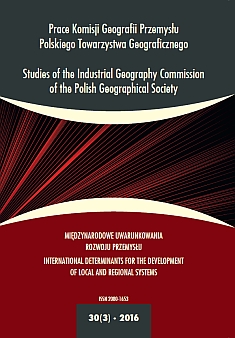Problems of Development of Offshore Wind Power in the Southern Baltic
DOI:
https://doi.org/10.24917/20801653.303.13Keywords:
offshore wind energy (OWE), south Baltic Sea, subsea power cablesAbstract
According to the assumptions adopted by the European Union, the average share of renewableenergy in the consumption of gross final energy in 2020 in member states should reach 20%. It is estimatedthat approx. 60-70% of this amount will be energy obtained from wind. This includes energy from offshorewind farms whose numbers, due to fewer restrictions regarding their location, much better aerodynamicconditions (windiness), favourable legal and financial conditions and the possibility of using larger and moreefficient equipment, have been rapidly growing for a decade. Thus, the possibility of development of offshorewind energy (OWE) in the southern Baltic in light of European solutions, with particular emphasis on Polishexperience started to appear in considerations. An analysis of the potential of establishing offshore windfarms and marine power lines and them operating in the current and the anticipated state of the law has beenconducted. Due to the nature of the spatial and organizational structure of OWE a lot of attention has beendevoted to the analysis of international conditions of operation of offshore wind farms in Europe, includingthose in the southern Baltic. Current findings indicate that the prospects for development of this type of energyare strongly determined not only by economic factors but also by political factors on the national andinternational level.Downloads
Metrics
References
Ackermann, T. (2005). Transmission systems for offshore wind farms. W: Wind power in power systems. Sztokholm: Royal Institute of Technology.
Blažauskas, N., Włodarski, M., Paulauskas, S. (2012). Perspektywy rozwoju morskiej energetyki wiatrowej w krajach wschodniego Bałtyku. Kłajpeda: Wydawnictwo Instytutu Badań Przybrzeżnych i Planowania, UK.
Blyth, W. (2014). Low carbon jobs: The evidence for net job creation from policy support for energy efficiency and renewable energy. London: UK Energy Research Centre.
Bukowski, M., Śniegocki, A. (2015). Wpływ energetyki wiatrowej na polski rynek pracy. Warszawa: Warszawski Instytut Studiów Ekonomicznych.
Chojnacki, I. (2011) (2015, 28 grudnia). RWE: planowane inwestycje w polską energetykę wiatrową to 2 mld zł do 2015 roku. Wirtualny Nowy Przemysł. Pozyskano z http://energetyka.wnp.pl/rwe-planowane-inwestycje-w-polska-energetyke-wiatrowa-to-2-mld-zl-do-2015-roku, 150436_1_0_0.html
Ciżkowicz, P., Gabryś, A., Baj, K., Bawół, M. (2012) (2016, 10 lutego). Wpływ energetyki wiatrowej na wzrost gospodarczy w Polsce. Raport Ernst & Young. Pozyskano z http://www.domrel.pl/_publikacje/raport_psew_2012.pdf
Cox, S.J., Cheyne, A.J.T. (2000). Assessing safety culture in offshore environments. Safety Science, 1–3, 111–129.
Gill, A.B. (2005). Offshore renewable energy: ecological implications of generating electricity in the coastal zone. Journal of Applied Ecology, 4, 605–615.
Gutkowski, B., Witoński, M., Joeck, R. (2012). Koncepcja rozwoju sieci morskich na Morzu Bałtyckim. Czysta Energia, 6.
Huber, M. (2015). Supergrid. München: Technische Universität.
Koncepcja Przestrzennego Zagospodarowania Kraju 2030 (2011) (2016, 10 lutego). Pozyskano z http://mr.bip.gov.pl/strategie-rozwoj-regionalny/17847_strategie.html
Kopits, S., Westwood, A. (2009) (2015, 29 grudnia). Offshore Wind: Time for a Market Take-off? Renewable Energy World, 8. Pozyskano z http://ec.europa.eu/maritimeaffairs/index_pl.htm
Lewandowski, W.M. (2010). Proekologiczne odnawialne źródła energii. Warszawa: Wydawnictwo Naukowo-Techniczne.
Morska Farma Wiatrowa Bałtyk Środkowy III. Raport o oddziaływaniu na środowisko (2015). Warszawa: Grupa Doradcza SMDI.
Strupczewski, A. (2007). Czy Polska powinna iść „duńską” drogą? Krótkie porównanie elektrowni wiatrowych i jądrowych. Warszawa: Narodowe Centrum Badań Jądrowych.
Strupczewski, A. (2014). Czy farmy wiatrowe mogą zastąpić elektrownie jądrowe? Warszawa: Narodowe Centrum Badań Jądrowych.
Subsidies and costs of EU energy (2014). Brussels: Ecofys by order of European Commission.
The European offshore wind industry – key trends and statistics 2014 (2015). Brussels: European Wind Energy Association.
What is the real cost of offshore wind? (2014). Hamburg: Siemens AG, Wind Power.
Wiśniewski, G., Michałowska-Knap, K., Koć, S. (2012). Energetyka wiatrowa – stan aktualny i perspektywy rozwoju w Polsce. Warszawa: Instytut Energetyki Odnawialnej (EC BREC IEO).
Downloads
Published
How to Cite
Issue
Section
License
Articles are published under the terms of the Creative Commons License (CC BY-ND 4.0; Attribution– NoDerivs).

